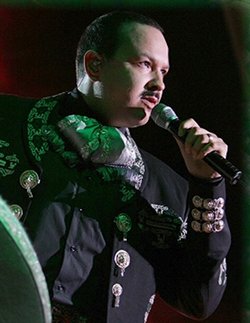Ranchera
| Ranchera | |
|---|---|
| Stylistic origins | Mariachi |
| Cultural origins | |
| Typical instruments | Guitar, vihuela, trumpet, violin, guitarrón, harp, harmonica |
| Subgenres | |
| bolero-ranchero, corrido, | |
| Other topics | |
| Charro - Jarabe Tapatío (also the name of a song) - Zapateado - Son Huasteco - Huapango - Mexican pop | |
Ranchera (pronounced [ranˈtʃeɾa]), or canción ranchera is a genre of the traditional music of Mexico. It dates before the years of the Mexican Revolution. It later became closely associated with the mariachi groups which evolved in Jalisco. Ranchera today is also played by norteño (or Conjunto) or banda and Tamborazo. Drawing on rural traditional folk music, ranchera developed as a symbol of a new national consciousness in reaction to the aristocratic tastes of the period. Some well-known interpreters of the genre are the following singers: Amalia Mendoza, Antonio Aguilar, Chelo, Cuco Sánchez, Flor Silvestre, Irma Serrano, Javier Solís, Jorge Negrete, José Alfredo Jiménez, Lola Beltrán, Lucha Villa, Pedro Infante, Rocío Dúrcal and Vicente Fernández.
Definitions

Traditional rancheras are about love, patriotism or nature. Rhythms can have a metric in 2/4 (ranchera polkeada), 3/4 (ranchera valseada), or 4/4 (bolero ranchero) reflecting the tempo of, respectively, the polka, the waltz, and the bolero. Songs are usually in a major key, and consist of an instrumental introduction, verse and refrain, instrumental section repeating the verse, and another verse and refrain, with a tag ending. Instrumentation may include guitars, strings, trumpets, and/or accordions, depending on the type of ensemble being utilised. Besides the typical instrumentation, ranchera music, as well as many other forms of traditional Mexican music, is also noted for the grito mexicano, a yell that is done at musical interludes within a song, either by the musicians and/or the listening audience.

The normal musical pattern of rancheras is a/b/a/b. Rancheras usually begin with an instrumental introduction (a). The first lyrical portion then begins (b), with instrumental adornments interrupting the lines in between. The instruments then repeat the theme again, and then the lyrics may either be repeated or begin a new set of words. One also finds the form a/b/a/b/c/b used, in which the intro(a) is played, followed by the verse(b). This form is repeated, and then a refrain(c) is added, ending with the verse.
The most popular ranchera composers include Lucha Reyes, Cuco Sánchez, Antonio Aguilar, Juan Gabriel and José Alfredo Jiménez, who composed many of the best-known rancheras, with compositions totaling more than 1000 songs, making him one of the most prolific songwriters in the history of western music.
Another closely related style of music is the corrido, which is often played by the same ensembles that regularly play rancheras. The corrido, however, is apt to be an epic story about heroes and villains, whereas rancheras may not necessarily be heroic ballads, and also vary more in terms of tempo. However, two notable exceptions to this rule are the songs, 'Corrido de Chihuahua' and the 'Corrido de Monterrey', which are considered rancheras in spite of their names. Their lyrics are concerned with patriotism for the states of Chihuahua and Nuevo León, respectively.
The word ranchera was derived from the word rancho because the songs originated on the ranches and in the countryside of rural Mexico. Rancheras that have been adapted by conjuntos, or norteño bands from northern Mexico and the southwestern US, are sometimes called norteños, from the Spanish word for northern.
Well-known examples



- "Amanecí en tus brazos" (I awoke in your arms) by José Alfredo Jiménez and performed by Rocío Dúrcal, Vikki Carr, Javier Solís, Luis Miguel, and others.
- "Amor eterno" (Eternal Love) by Juan Gabriel
- "Ay, Jalisco, no te rajes!" (Hey, Jalisco, don't back down),by Jorge Negrete
- "Camino de Guanajuato" (Road to Guanajuato) by José Alfredo Jiménez and Pedro Fernández
- "Carta a Eufemia" (Letter to Eufemia) by Pedro Infante
- "Cielito lindo" (Lovely little Heaven) by Vicente Fernández and many others.
- "Cielo rojo" (Red sky) by Flor Silvestre
- "Cien años" (One hundred years) by Pedro Infante
- "Corazón, corazón" (My heart, my heart) by Lola Beltrán and Lucha Villa.
- "Corrido de Chihuahua" (The Chihuahua corrido) by Lucha Villa, Miguel Aceves Mejía and Antonio Aguilar
- "Corrido de Monterrey" (The Monterrey corrido) by David Zaizar, Lorenzo de Monteclaro and Vicente Fernández
- "Costumbres" (Customs) by Rocío Dúrcal
- "Cuatro caminos" (Four roads) by José Alfredo Jiménez and Lola Beltrán
- "Cucurrucucú paloma" (Cooing dove) by Trini Lopez, Rosemary Clooney, Lola Beltrán and Rocío Dúrcal.
- "De qué manera te olvido" (How can I forget you) by Rocío Dúrcal, Vicente Fernández. and others.
- "Duele" (Hurts), by Elida Reyna
- "Echame a mí la culpa" (Put the blame on me), by José Ángel Espinoza and performed by Albert Hammond, Bertín Osborne, Amalia Mendoza, Flor Silvestre, Javier Solís, Luis Miguel, Rocío Dúrcal, and others.
- "El crucifijo de piedra" (The stone crucifix) by Miguel Aceves Mejía
- "Ella" (She) by José Alfredo Jiménez, Pedro Fernández, Vicente Fernández, and others.
- "El pastor" (The shepherd) by Miguel Aceves Mejía
- "El puente roto" (The broken bridge) by Irma Serrano
- "El rey" (The king) by José Alfredo Jiménez, Luis Miguel and Vicente Fernández.
- "El siete mares" (The Seven Seas), by José Alfredo Jiménez
- "La cruz de olvido" (The cross of forgetfulness), by Juan Zaizar and Álvaro Torres.
- "La puerta negra" (The black door), by Antonio Aguilar
- "Media vuelta" (The turn around), by Javier Solís, Lucha Villa, Rocío Dúrcal and Luis Miguel.
- "México lindo y querido" (Lovely and beloved Mexico), by Jorge Negrete, Alejandro Fernández
- "Mi destino fue quererte" (My destiny was to love you), by Flor Silvestre
- "Miel amarga" (Bitter honey), by Irma Serrano
- "Noches eternas" (Eternal nights), by Vicente Fernández
- "No me queda más" (There's Nothing Left for Me), by Selena
- "Pa' todo el año" (For the whole year), by José Alfredo Jiménez, Flor Silvestre, Vicente Fernández, Pedro Fernández, and others.
- "Payaso" (Clown), by Javier Solís, Vikki Carr
- "Poco a poco" (Little by little), by Javier Solís
- "Por tu maldito amor" (For your damn love), by Vicente Fernández
- "Por una mujer casada" (For a married woman), by David Záizar
- "Si nos dejan" (If they let us), by Bertín Osborne, Rocío Dúrcal, José Alfredo Jiménez, Lola Beltrán, Vikki Carr, Luis Miguel. and others.
- "Sombras" (Shadows), by Javier Solís, Vikki Carr and others.
- "Tierra mala" (Bad soil), by Irma Serrano
- "Tú Sólo Tú" (You, Only You), by Selena
- "Una limosna" (An alm), by Flor Silvestre and Javier Solís
- "Un puño de tierra" (A handful of earth), by Antonio Aguilar
- "Volver, volver" (Coming back, coming back), by Vicente Fernández, Bertín Osborne and others.
Celebrated ranchera singers
- Miguel Aceves Mejía
- Antonio Aguilar
- Pepe Aguilar
- Lola Beltrán
- Vikki Carr
- Aida Cuevas
- Yolanda del Rio
- Rocío Dúrcal
- Alejandro Fernández
- Pedro Fernández
- Vicente Fernández
- Pedro Infante
- José Alfredo Jiménez
- Amalia Mendoza
- Lorenzo de Monteclaro
- Jorge Negrete
- Lucha Reyes
- Cuco Sánchez
- Irma Serrano
- Flor Silvestre
- Javier Solís
- Chavela Vargas
- Lucha Villa
See also
References
- Brenner, H. (1996). Música ranchera. Das mexikanische Äquivalent zur Country and Western Music aus historischer, musikalischer und kommerzieller Sicht (Música ranchera: El equivalente mexicano de la música country y la música del Oeste) (Musikethnologische Sammelbände 14). Foreword by Thomas Stanford. Tutzing: Verlag Hans Schneider, 1996 [ISBN 3 7952 0867 X].
External links
- Musical analysis
- Northern ranchera lyrics
- Erichsen, Gerald. "German roots of Mexican Music". Retrieved 12 April 2013.
